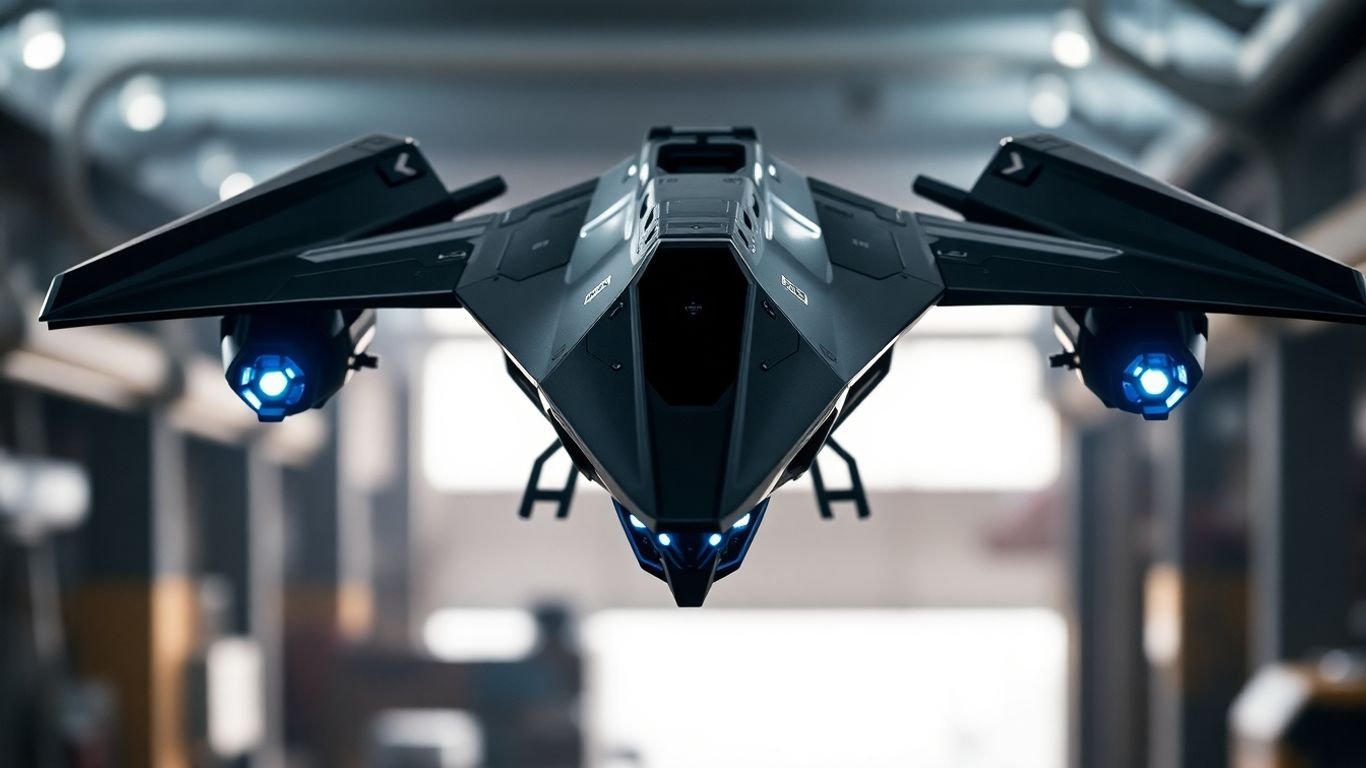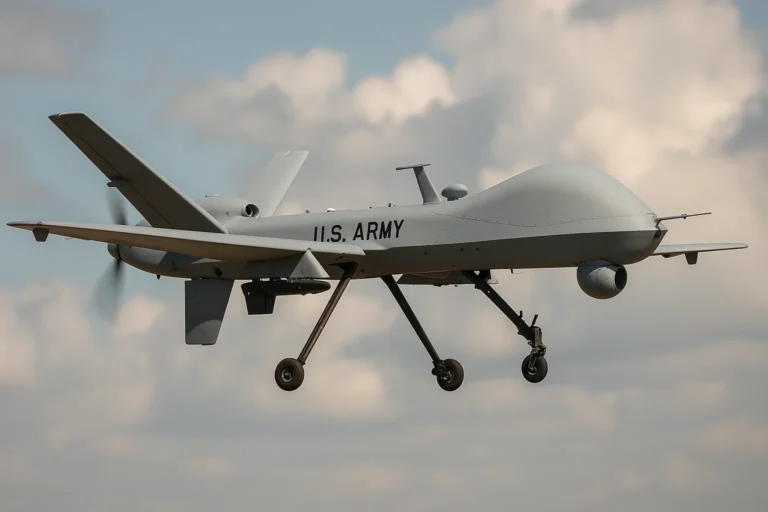Germany’s Helsing Unveils AI-Powered ‘Europa’ Combat Drone

Germany’s defense tech startup, Helsing, has just pulled back the curtain on its new AI-powered combat drone, the Europa. This isn’t just another drone; it’s designed to be a big part of how future air wars might be fought. Think swarms of these things, or them working alongside fighter jets. Helsing is talking about making them in Europe, for Europe, and they’re aiming for a first flight pretty soon. It’s a pretty big move in the world of military tech.
Key Takeaways
- Helsing has revealed the CA-1 Europa, an AI-driven combat drone aimed at reshaping aerial warfare with autonomous capabilities.
- The Europa drone is designed for mass production, focusing on affordability and flexibility for European defense needs.
- Key AI systems like Centaur, Cirra, and Symphony are integrated to manage flight, electronic warfare, and mission coordination.
- The drone is intended to operate in various ways, including solo missions, swarm formations, or as a ‘loyal wingman’ to crewed aircraft.
- Helsing emphasizes European sovereignty in defense technology, aiming to build a resilient supply chain for the Europa combat drone.
Helsing Europa Combat Drone Unveiled

Germany’s own Helsing, a notable European defense startup, has pulled back the curtain on its latest creation: the Helsing Europa combat drone. This isn’t just another remote-controlled plane; it’s a significant step towards autonomous warfare, aiming to reshape how air forces operate. The Europa represents a new wave of uncrewed combat aerial vehicles designed for the modern battlefield.
Helsing Europa: A New Era of Autonomous Warfare
The unveiling of the Helsing Europa combat drone marks a potential turning point for European defense. This AI-powered machine is built with the idea of ‘intelligent mass’ in mind, meaning it’s designed to be produced in large numbers and deployed flexibly. It’s not meant to replace crewed aircraft entirely, but rather to work alongside them, acting as a smart wingman drone technology. Think of it as a highly capable, expendable asset that can take on dangerous missions without risking a pilot’s life.
First Flight and Operational Readiness Timeline
So, when can we expect to see this advanced piece of German autonomous drone technology in action? Helsing is aiming for the Europa’s first flight in 2027. Following that, they project it will be ready for military use within about four years, putting operational readiness around 2031. This timeline shows a focused effort to bring this new capability to market relatively quickly.
Strategic Investment in European Defense Capabilities
Helsing isn’t just building a drone; they’re investing heavily in the broader European defense ecosystem. They plan to pour hundreds of millions of euros into development, working with various European companies. This move highlights a push for strategic autonomy, ensuring that Europe can develop and produce its own advanced defense systems, reducing reliance on external partners. It’s a big play for sovereign solutions in a rapidly evolving global market.
The Helsing Europa’s Advanced AI Integration

The Helsing Europa isn’t just another drone; it’s built from the ground up with artificial intelligence at its core. This isn’t some add-on feature; it’s the whole point. Think of it as a new breed of AI-powered UCAV, designed to think and act autonomously. The CA-1 Europa first flight is slated for 2027, and a lot of that timeline hinges on the AI systems working perfectly. The company’s acquisition of Grob Aircraft was a big step, giving them the manufacturing base needed for this advanced tech.
Centaur AI Pilot: The Brains Behind the Europa
At the heart of the Europa is the Centaur AI pilot. This isn’t just autopilot; it’s a sophisticated system trained to handle complex aerial combat scenarios. Helsing has already shown what Centaur can do, putting it in control of a Gripen fighter jet. It managed difficult maneuvers and even simulated engaging enemy aircraft. This level of AI autonomy is what sets the Europa apart.
Cirra and Symphony: Enhancing EW and Mission Coordination
But Centaur isn’t alone. The Europa also features Cirra, an AI system focused on electronic warfare. Its job is to jam and counter enemy radar and communication systems, which is pretty important in modern conflicts. Then there’s Symphony, a platform that coordinates multiple drones. It allows them to work together, like a well-oiled machine, whether they’re operating as a swarm or supporting other aircraft. This coordination is key for missions where you need many assets working in sync.
Human-Machine Collaboration in Combat Scenarios
It’s not all about the AI going rogue, though. The Europa is designed for human-machine collaboration. Operators can plan missions and supervise the drone’s actions. The AI handles the split-second decisions in combat, but humans are still in the loop for oversight and strategic direction. It’s about using AI to make human pilots and ground crews more effective, not replacing them entirely. This partnership is seen as the future of air combat, blending the speed of AI with the judgment of human experience.
Design and Capabilities of the Helsing Europa
The Helsing Europa combat drone, officially the CA-1 Europa, is built with a focus on what the company calls ‘intelligent mass.’ This means it’s designed to be produced in large numbers affordably, making it a flexible option for various combat situations. It’s not just about having one super-advanced drone; it’s about having many that can work together. The airframe itself is pretty interesting, weighing in at about three to five tons. It has a distinctive look with cranked kite wings and angled tail fins, plus side air intakes feeding a single engine. Helsing has put a lot of thought into making it adaptable.
Intelligent Mass: Mass-Produceable Airframe Design
This drone is all about being able to churn them out. The design prioritizes ease of manufacturing and a relatively low unit cost, which is a big deal when you’re thinking about deploying them in large numbers. The airframe is optimized for this kind of production.
- Lightweight yet robust construction
- Modular components for easier assembly
- Designed for high-volume production lines
The goal here is to create a system that can be fielded widely, providing a significant presence without breaking the bank. It’s a shift from the idea of a few very expensive, highly specialized platforms to many capable, more accessible ones.
Multi-Role Mission Flexibility
One of the standout features of the Europa is its ability to switch between different jobs. It’s not a one-trick pony. Helsing has designed it to handle a variety of tasks, from hitting targets deep behind enemy lines to jamming enemy communications and even scouting.
- Deep Precision Strike: Taking out high-value targets.
- Electronic Warfare (EW): Disrupting enemy systems and communications.
- Reconnaissance and Intelligence: Gathering information without risking pilots.
- Suppression of Enemy Air Defenses (SEAD): Neutralizing air defense threats.
This adaptability means a single type of drone can fill multiple roles in an air force’s arsenal, simplifying logistics and training. It’s a key part of the Helsing CA-1 Europa concept.
Scalability and Resilient European Supply Chains
Helsing is really pushing the idea that the Europa drone is about more than just its technical specs; it’s about Europe’s ability to make its own advanced defense tech. They’re building it with European software and manufacturing partners to cut down on reliance on outside sources. This is a big deal for strategic autonomy. The plan is to build a network of factories across Europe to make sure production can keep up and isn’t easily disrupted. This approach aims to create a strong, independent European defense industrial base for these kinds of autonomous systems.
Helsing Europa in the Global Combat Drone Market
The global stage for combat drones is getting pretty crowded, and Helsing’s new Europa drone is stepping right into the thick of it. It’s not just about building another drone; it’s about carving out a space in a market that’s rapidly changing. We’re seeing a big push for what they call ‘Collaborative Combat Aircraft,’ or CCAs, and the Europa is Helsing’s answer to that. This is all part of a larger trend where defense companies are looking for more agile and cost-effective ways to build military hardware.
Competition in the Collaborative Combat Aircraft Sector
It feels like every major defense player, and a lot of the newer tech companies, are trying to get a piece of the CCA pie. You’ve got big names like the US Air Force already working with companies like Anduril and General Atomics on their own CCA fleets. Then there’s Airbus, showing off their drone concepts too. Helsing is positioning the Europa as a distinctly European option in this race. They’re not just competing on features; they’re aiming for a specific niche.
European Strategic Autonomy and Sovereign Solutions
This is a big deal for Europe. A lot of countries have been a bit uneasy about relying too heavily on defense tech from outside the continent. Helsing is really leaning into this, making sure the Europa is built with European software and a European manufacturing base. The idea is to reduce dependence on other countries for these advanced systems. It’s about having control over your own defense capabilities, which makes a lot of sense, especially with everything going on in the world. This push for sovereign solutions is becoming a major factor in defense procurement.
Cost-Effectiveness and Attritable Systems
Nobody wants to send their most expensive assets into high-risk situations if they don’t have to. That’s where the concept of ‘attritable systems’ comes in. These are drones designed to be produced in larger numbers and are more affordable, meaning they can be lost in combat without breaking the bank. Helsing is talking about ‘intelligent mass’ with the Europa – the ability to field a lot of these drones without a massive financial hit. This makes them useful for a variety of missions where you might need to overwhelm an adversary or operate in very contested airspace. It’s a smart way to think about future air combat, focusing on quantity and affordability alongside advanced tech.
The future of air combat is shifting. Instead of relying on a few very expensive, highly advanced manned aircraft, the trend is moving towards a mix of platforms. This includes more autonomous systems that can work together, offering flexibility and reducing risk to human pilots. The Europa fits right into this evolving picture.
Here’s a quick look at how the Europa stacks up conceptually:
- Mass-Produceable Airframe: Designed for efficient manufacturing.
- Multi-Role Capability: Can handle different types of missions.
- European Supply Chain Focus: Built with continental partners.
- AI-Driven Autonomy: Core to its operational concept.
It’s clear that Helsing isn’t just building a drone; they’re trying to build a whole new approach to air power for Europe.
Operational Concepts for the Helsing Europa
The Helsing Europa isn’t just a drone; it’s designed to be a flexible tool for modern air forces, capable of handling a wide range of tasks. Think of it as a digital soldier that can be sent into situations where putting a human pilot at risk just isn’t smart. Its core idea is to provide a capable, autonomous platform that can operate in various ways, adapting to the mission at hand.
Single-Asset Missions and Swarm Operations
One of the Europa’s key strengths is its versatility. It can fly solo, taking on missions that require a single, highly capable asset. This could be anything from deep strikes into enemy territory to electronic warfare missions designed to disrupt enemy communications and radar. But where it really shines is in swarm operations. Imagine a group of these drones working together, coordinated by AI, to overwhelm enemy defenses or conduct complex reconnaissance. This isn’t just science fiction; it’s the future of how air power will be used.
- Solo Missions: Ideal for high-risk, precision tasks where a single, intelligent platform is sufficient.
- Swarm Tactics: Multiple Europas acting in concert, increasing survivability and mission effectiveness through distributed capabilities.
- Coordinated Attacks: Swarms can be used to saturate enemy air defenses, allowing other assets, like crewed aircraft, to operate more safely.
The ability to operate as a coordinated swarm fundamentally changes the tactical landscape. It allows for a more distributed and resilient approach to air operations, making it harder for adversaries to counter the entire force.
Loyal Wingman Role with Crewed Fighters
Another exciting concept is the Europa’s role as a ‘loyal wingman’ for traditional fighter jets. Picture a pilot in an F-35 or Eurofighter, with one or more Europas flying alongside them. These drones can act as an extension of the crewed fighter, carrying extra weapons, performing reconnaissance, or even acting as decoys. This allows the human pilot to focus on the bigger picture while the drones handle more immediate threats or tasks. It’s all about making the human pilot more effective and survivable.
Dispersed Operations and Minimal Infrastructure Deployment
Forget about needing massive airbases for the Europa. This drone is designed to be deployed from almost anywhere. Think small, forward operating locations, or even improvised strips of land. This makes it incredibly hard for an enemy to target and destroy the drone’s launch and recovery infrastructure. It’s a game-changer for operating in contested environments where traditional airbases might be too vulnerable.
- Reduced Footprint: Operates effectively from locations requiring minimal logistical support.
- Increased Survivability: Harder for adversaries to locate and attack the operational base.
- Rapid Redeployment: Can be quickly moved and set up in new locations as the tactical situation changes.
What’s Next for Europa?
So, Helsing’s Europa drone is definitely a big deal, aiming to hit the skies by 2027. It’s all about using AI to make drones smarter and more capable, whether they’re flying solo or working with other aircraft. This move shows Europe is serious about building its own advanced defense tech, trying to keep up with the fast pace of military innovation. It’s going to be interesting to see how this all plays out, especially with other companies also working on similar projects. We’ll have to wait and see if the Europa lives up to all the hype and what role it ends up playing in future defense strategies.
Frequently Asked Questions
What is the Helsing Europa combat drone?
The Helsing Europa is a new type of military drone that can fly and fight on its own, without a human pilot. It’s designed to be smart, work with other drones, or fly alongside regular fighter jets. Think of it as a robot airplane that can help in battles.
When will the Europa drone be ready for action?
Helsing plans to have the Europa drone fly for the first time in 2027. They expect it to be ready for military use a few years after that, likely within the next four years.
What makes the Europa drone special?
It’s special because it uses advanced Artificial Intelligence (AI) to make decisions. It has an AI pilot called ‘Centaur’ and other AI systems to help it fight, jam enemy signals, and work together with other machines. It’s also designed to be built in large numbers and be affordable.
Can the Europa drone fly by itself or does it need other planes?
The Europa drone is very flexible. It can fly missions all by itself, work as part of a big group of drones flying together (like a swarm), or act as a ‘wingman’ for human-piloted fighter jets.
Is this drone being built in Europe?
Yes, Helsing is focused on making the Europa drone a European product. They want to build it using European companies and technology to make sure Europe can make its own advanced defense systems without relying on other countries.
How is the Europa different from other combat drones?
The Europa is designed for ‘intelligent mass,’ meaning it can be built in large numbers affordably. It also heavily relies on AI for its brain and uses a special system to coordinate with other drones. This makes it a modern, flexible, and potentially cheaper option compared to older, more expensive warplanes.






